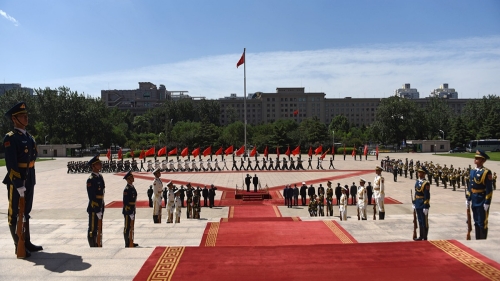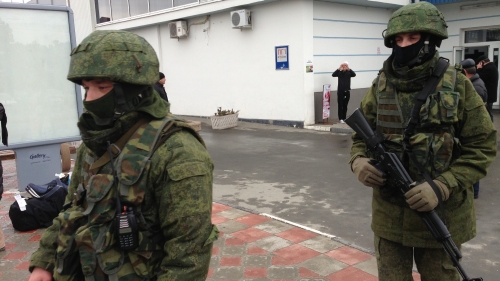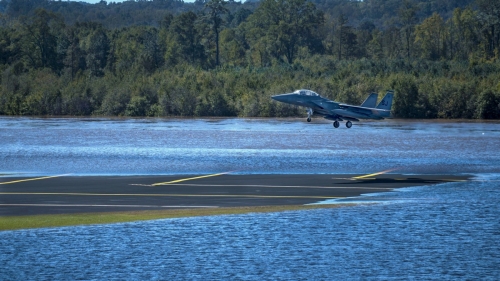 Capt. Garrett Sinclair, 347th Operations Support Squadron chief of weapons and tactics, analyzes a computer during exercise FT 19-04, April 18, 2019, at Moody Air Force Base, Ga. The five-day exercise will give base personnel an opportunity to experience contingency operations in a contested and degraded combat environment. During the exercise, personnel will be evaluated on how well they defend and recover the base from ground-opposition forces, as well as mortar and missile attacks, while in mission oriented protective posture gear. (This photo has been altered for security purposes by blurring out sensitive equipment.)
Capt. Garrett Sinclair, 347th Operations Support Squadron chief of weapons and tactics, analyzes a computer during exercise FT 19-04, April 18, 2019, at Moody Air Force Base, Ga. The five-day exercise will give base personnel an opportunity to experience contingency operations in a contested and degraded combat environment. During the exercise, personnel will be evaluated on how well they defend and recover the base from ground-opposition forces, as well as mortar and missile attacks, while in mission oriented protective posture gear. (This photo has been altered for security purposes by blurring out sensitive equipment.)
U.S. Air Force photo by Airman 1st Class Taryn Butler
Where will the next war occur? Who will fight in it? Why will it occur? How will it be fought? This brief summarizes a series of reports that sought to answer these questions—looking out from now until 2030. The reports took the approach of examining these questions through the lenses of several trends—geopolitical, economic, environmental, legal, informational, and military—that will shape the contours of conflict.
Military history is littered with mistaken predictions about the future of warfare that have left forecasters militarily unprepared—sometimes disastrously so—for the conflicts ahead. The United States has suffered its own share of bad predictions.
"When it comes to predicting the nature and location of our next military engagements, since Vietnam, our record has been perfect. We have never gotten it right, from the Mayagüez to Grenada, Panama, Somalia, the Balkans, Haiti, Kuwait, Iraq, and more—we had no idea a year before any of those missions that we would be so engaged."
U.S. Secretary of Defense Robert Gates in a speech at the U.S. Military Academy, West Point, N.Y., February 25, 2011
Why do predictions about the future of warfare usually fall flat? More often than not, poor predictions stem from failing to think holistically about the factors that drive changes in the environment and the implications of those factors for warfare. Such considerations go well beyond understanding the operational implications of technology and include geopolitical, environmental, and economic changes. Furthermore, such factors as international laws, public opinion, and media coverage can constrain how states use force and, thus, how wars are fought.
Although successfully predicting the future of warfare is notoriously difficult, the U.S. military, for better or worse, is deeply invested in the forecasting business. All the armed services want to understand what the future of conflict holds for them because, given how long it takes to develop capabilities, they must gamble today on what kinds of technology and people they will need to win tomorrow's wars.
This brief summarizes a comprehensive examination of the factors that shape conflict and how these variables interact with one another. It starts by identifying the key three dozen or so geopolitical; military; space, nuclear, and cyber; restraint; economic; and environmental trends that will shape the future of warfare from now until 2030. This brief then aggregates these trends to paint a holistic picture of the future of warfare—the potential U.S. allies and enemies, where conflicts will occur, what they might look like, how the United States will wage them, and when and why the United States might go to war in the first place. The brief concludes by describing the implications of this work for the U.S. Air Force (USAF) and the joint force.
In determining trends, RAND researchers reviewed scholarly work, analyzed different data sets and topics of interest, conducted extensive field research, and relied on professional judgment. All told, the RAND team interviewed more than 120 different government, military, academic, and policy experts from more than 50 different institutions in Belgium, China, Germany, Israel, Japan, Jordan, Poland, the United Arab Emirates, and the United Kingdom (UK) for their perspectives on regional and global trends that might shape the future of conflict between now and 2030.
Geopolitical Trends

U.S. Secretary of Defense James N. Mattis meets with China's Minister of National Defense Wei Fenghe at the Bayi Building, China's Ministry of National Defense in Beijing, June 27, 2018.
U.S. polarization and retrenchment. The American public is becoming increasingly polarized on many issues—including foreign and defense policy—which is producing political gridlock in the United States. This gridlock will limit the nation's ability to do the tasks needed to act effectively as a global superpower, from resourcing the defense budget to responding to international crises in a coherent and unified way. Just as troubling, politicians might increasingly look for military solutions because the military is one of the few government institutions that Americans trust. These political ills show no sign of abating and could even increase in years to come.
China's rise. Increasing questions about U.S. leadership on the international stage would not be as serious if it were not for the other five trends in this category. China's president, Xi Jinping, recently waived term limits and promised "the great rejuvenation of China"—a commitment to restoring China to what it perceives as its rightful place on the world stage and reversing its "century of humiliation."
Asia's reassessment. As China rises, other states—particularly in Asia—are reacting to their larger, more powerful neighbor's growing ambitions by rethinking whether to get on the bandwagon with China or balance against China's rise.
A revanchist Russia. Although Russia is arguably a declining power, it is growing more aggressive, intervening in Georgia, Ukraine, and Syria and reaffirming its position as a great power.
Upheaval in Europe. The European Union is becoming more fractured, less interested in expeditionary operations, and increasingly inward-looking, facing an immigration crisis, the growth of right-wing populism, and the lingering effects of the euro crisis.
Turmoil in the Islamic world. Even after a decades-long international counterterrorism campaign, the Middle East remains afflicted with Islamic jihadist terrorism, systemic poor governance, economic issues, and growing tensions between Iran and Saudi Arabia and between Iran and Israel that are already shaping conflicts in Syria, Yemen, and beyond.
None of these problems appear likely to be resolved anytime soon and will likely shape the contours of conflict in the years to come.
Military Trends

Photo by Voice of America/Wikipedia Creative Commons
Decreasing U.S. conventional force size. U.S. conventional overmatch is declining. Despite the "reemergence of long-term, strategic competition" noted in the 2018 National Defense Strategy, the U.S. military will likely remain a fraction of the size it was during the Cold War, which was the last period of long-term, strategic competition, and it will lack the technological superiority it enjoyed during the immediate aftermath of the Persian Gulf War.
Increasing near-peer conventional modernization and professionalism. The Chinese and (to a lesser extent) Russian militaries are becoming increasingly capable, as both continue to modernize and professionalize. In China's case, especially, these military improvements likely will continue, closing the qualitative gap between the People's Liberation Army and the U.S. military.
Selectively capable second-tier powers —such as Iran and North Korea—cannot militarily match the United States and instead are increasingly turning to asymmetric capabilities—such as cyber operations, missiles, and weapons of mass destruction—to counter conventional U.S. superiority. If such strategies ultimately lead to war, U.S. forces will need to find ways to neutralize these asymmetric capabilities and destroy substantial portions of those adversaries' large but less-sophisticated forces.
Adversary use of gray-zone tactics. Almost as important as the changes in their military capabilities are the changes in tactics that U.S. adversaries are using to operate in the gray zone—employing incremental aggression, information warfare, proxy forces, and covert special operations forces to obtain regional objectives while staying below the U.S. threshold of conventional response.
Weakening of the state monopoly on violence. Part of the success of gray-zone tactics stems from this trend. Thanks to changes in military and communications technology, nonstate actors—or, in the case of gray-zone conflicts, proxy forces—can destabilize states with increasing ease.
Artificial intelligence (AI) as a class of disruptive technologies. Developments in military applications of AI might help U.S. forces achieve objectives in both conventional and unconventional operations, thereby mitigating some of these trends. But these capabilities come with serious risks that will need to be managed, and the United States will not have a monopoly on access to AI. U.S. leaders will need to find ways to maximize the benefits that AI offers while mitigating the inevitable risks.
Taken together, these trends point to the fact that, as the 2018 National Defense Strategy argues, "competitive military advantage has been eroding" and, if unaddressed, will allow U.S. adversaries to exploit these weaknesses to their own advantages.
Space, Nuclear, and Cyber Trends
Being able to use space-based assets for intelligence, communication, and navigation has long been one of the cornerstones of the U.S. military's advantage, but future U.S. dominance in space could be subject to two countervailing trends. Nuclear trends present a cleaner, if less rosy, picture of the future.

A Delta IV rocket successfully launches the Global Positioning System IIF-5 satellite Feb. 20, 2014 from Space Launch Complex-37 at Cape Canaveral Air Force Station, Fla.
Photo by United Launch Alliance/Ben Cooper
Space is becoming an increasingly contested environment. Both China and Russia are improving their abilities to disable and destroy satellites.
Proliferation of commercial space capabilities. The commercial exploitation of space has exploded in recent years and the trend is likely to continue through 2030. As greater numbers of commercial entities launch microsatellites for imagery and communications purposes, the overall U.S. space infrastructure could grow more resilient—provided that the United States can leverage these commercial investments.
Resumption of nuclear proliferation. Several second-tier states—most notably Iran and North Korea—have pushed to develop nuclear weapons. And despite concerted international diplomatic efforts to prevent nuclear proliferation (in the former's case) or roll it back (in the latter's), it remains unclear whether either effort will be successful. Should these efforts fail, Iranian and North Korean nuclear proliferation might spur further regional nuclear proliferation, preventative military strikes, and possibly even limited nuclear war.
Erosion of norms and treaties constraining tactical nuclear weapons use. At the same time, nuclear arms control regimes appear to be eroding, increasing the chances that Russia—and, to a lesser extent, China—might use tactical nuclear weapons in the future.
Information control. Control of the cyber domain will become increasingly central to domestic stability. The most extreme example is China, which tightly monitors the content its citizens can access and uses cybersurveillance for behavior control, but all states are concerned about preventing the cyber domain from becoming a tool for foreign subversion.
Cyber espionage. As more data are digitized and held in the cloud, the cyber domain will become the primary target of espionage efforts.
Cyber sabotage. In 2007, the U.S. intelligence community assessed that only a handful of countries had offensive cyber capabilities; in 2017, the number had grown to more than 30. At the same time, a great deal of critical U.S. infrastructure lies outside the direct control of the U.S. Department of Defense—and of the U.S. government—and thus poses a comparatively easy target for adversaries to attack.
Restraint Trends
All military capabilities matter only to the extent that actors decide to use them. A host of factors—such as international law, public opinion, media coverage, technological capabilities, partner preferences, and operational imperatives—shape the amount of restraint that combatants exercise in conflict, and many of these factors will increasingly weigh on how the United States—and its mostly liberal democratic allies and partners—will fight wars in the future.

Daily life in Zaatari refuggee camp in Jordan, located 10 km east of Mafraq, Jordan on June 04, 2014.
Photo by Dominic Chavez/World Bank
Widespread distribution of imagery of military operations. As smartphones and social media saturate the developing world, militaries will find themselves harder pressed to control both what images the public sees and the narrative surrounding operations.
Increasing public concern for civilian casualties. Domestic opinion in liberal democracies is increasingly sensitive to civilian casualties, especially in perceived wars of choice—and this is particularly relevant because of the aforementioned trend regarding the spread of imagery. By contrast, mostly authoritarian U.S. adversaries might not feel similarly constrained by their publics, by international opinion, or by international law.
The spread of lawfare. U.S. adversaries are also becoming increasingly adept at "lawfare"—manipulating asymmetric concern for international law to capitalize on U.S. and allied and partner restraint. Adversaries such as Hamas in Gaza, China in the South China Sea, and Russia in Ukraine have relied on this strategy to confound U.S. and allied and partner responses and will likely do so increasingly in the future.
Increasing power of false accusations. At the same time, media outlets in the United States have likely become more susceptible to disinformation because of the growing role of social media, an increasing distribution of opinions over facts in traditional media outlets, declining levels of trust in the government, and the rising influence of explicitly partisan news sources. These developments will give adversaries more opportunities to spread disinformation and to potentially undermine public support for U.S. or allied military action.
As a result of these influences, the United States might confront a widening "restraint gap" between how it and its allies and partners will use force in conflicts and how its adversaries will—particularly in wars waged on the lower ends of the conflict spectrum.
Global Economic Trends
Among the global economic trends, the first three increase the chances of future conflict, whereas the last three will shape how wars are fought. Notably, these effects are small and signal the need to increase watchfulness rather than raise alarm.

Photo by ronniechua/Getty Images
Increasing pressure on the global trading system. Protectionism is on the rise, although trade remains far freer today than it has been throughout most of the era since World War II. Even before the recent rounds of trade tariffs between the United States and China, governments had carried out more than 15,000 trade-related interventions between November 2008 and early 2018, most of them restraints.
The rise of China. China's economic ambitions are expanding. Its Belt and Road Initiative extends across Eurasia to increase connections with traditional U.S. allies (such as the UK, France, and Germany). As Chinese economic interests grow, so will Chinese security interests.
The search for new resources. The future global economy will require scarce resources—such as energy and a variety of minerals—for new technologies and industries, and restraints on trade of new sources for these items could increase the chances of conflict.
Relatively declining U.S. and allied economic might. As China rises, the United States and its allies will rise more slowly and thus make up a smaller share of global gross domestic product. Although the United States and its partners will still account for a larger share of the global economy than their potential adversaries by 2030, the United States will be less able to rely on the overwhelming economic dominance it has enjoyed in the latter half of the 20th century to give it a quantitative or even qualitative military advantage.
The shrinking defense industrial base. The United States and its allies will face fewer choices in 2030 for major weapon systems and a diminished capacity to ramp up production that might be needed for a major conflict. Causes include fewer prime contractors, less resiliency and redundancy among "warm" production lines and types of aircraft and other major equipment in production, rising technological complexity of weapons systems, and less high-skill engineering and technological expertise in the industrial manufacturing labor market.
Decreasing power of sanctions. The power to use economic sanctions might decline if other major economies develop alternative systems of international payments in reaction to sanctions overuse, if coordination among allies becomes more difficult, and if China makes its financial sector far more open than it is now. If that happens, the United States might need to resort to more-kinetic forms of coercion.
Environmental Trends
The future of warfare also will be shaped by several environmental trends.

Photo by Senior Airman Brittain Crolley/U.S. Air Force
Rising temperatures. Although the impact of climate change will be felt mostly in the far future of 2050 and beyond, global air surface temperatures will likely be 1 degree Fahrenheit warmer in 2030 than they were in the latter decades of the 20th century; this will affect health, reduce economic productivity, and contribute to a host of operational problems for basing aircraft in already hot parts of the globe, such as the Persian Gulf.
Water scarcity. Hotter temperatures can also cause a series of equally problematic second-order effects. One effect would be exacerbated potable water shortages, including in places already prone to instability and substate violence—particularly in the Middle East, sub-Saharan Africa, and parts of Asia.
Opening of the Arctic. Melting polar ice will make the Arctic more navigable and likely increase the chances of spillover conflict in the area among rival great powers—the United States, Russia, and China.
Sea level rise. At the same time, rising sea levels will cause humanitarian challenges and shift the geography in geopolitically sensitive regions, such as the South China Sea, thus affecting Chinese sovereignty claims.
Extreme weather events will not only increase the demand for disaster relief missions but also affect low-lying U.S. military bases, including those in strategic locations that are already at risk of flooding, such as the Marshall Islands, Guam, and Diego Garcia.
Urbanization and megacities. Geography will shape conflict in other ways. The global population is becoming more urbanized. For the first time, in 2008, more than half of the world's population lived in cities, and the number is growing. By 2030, the number of megacities—those with 10 million or more inhabitants—will expand from 31 to 41. As populations become more urbanized, particularly in the developing world, states will be harder pressed to maintain law and order; militaries in general—and airpower in particular—will face a more-difficult challenge of discriminating between military and civilian targets.
Predicting the Future of Warfare
From now through 2030, the locations where the United States is most likely to fight will not match where conflicts could be most dangerous to U.S. interests.
Based on the trend analysis described in the study, and assuming that the United States will try to maintain its position as the world's preeminent global military superpower, the United States will face a series of deepening strategic dilemmas when confronting warfare from now through 2030. U.S. adversaries—China, Russia, Iran, North Korea, and terrorist groups—likely will remain constant, but U.S. allies are liable to change as Europe becomes increasingly fragmented and inward-looking and as Asia reacts to the rise of China (see the "Allies in Flux" table). The locations where the United States is most likely to fight will not match where conflicts could be most dangerous to U.S. interests. The joint force will face at least four diverse types of conflict, each requiring a somewhat different suite of capabilities; at the same time, it will confront diminishing quantitative and qualitative military advantages (see the "Four Types of Conflict" and the "Declining Qualitative and Quantitative Advantage" tables). Above all, the United States of 2030 could progressively lose the capacity to dictate strategic outcomes and to shape when and why the wars of the future occur.
No comments:
Post a Comment